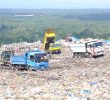(Last of Two Parts)
“We ran towards the mountains,” said Jocelyn Bocaron, who carried their four children including their youngest a one-year old infant to their safety amidst the wind. “The young coconut trees were not affected by the wind. We hid there until the strong winds subsided,” she said.
By JOHN RIZLE L. SALIGUMBA
Davao Today
CATEEL, Davao Oriental, Philippines — Rodelyn Ledesma was standing at the bayside of Cateel, Davao Oriental trying to take a video footage of the coming Typhoon Pablo (Bopha).
“I took a video because I wanted to record what Cateel looks like. I did not know that it would be something for us to remember by,” he said.
What Rodelyn got on his video was darkness. When dawn came, the impact of the typhoon became clear for the residents.
Pablo was the first typhoon in recent history to hit the coastal province of Davao Oriental in the Southern part of the Mindanao Island in the Philippines. But this left residents scarred from their first experience.
Many residents such as farmer Edwin Bocaron, 40 years old from Purok Bayabas, Carmen village of Boston said they were informed by the municipal police to evacuate as a storm was coming.
But for Bocaron, he thought the storm would be like the other storms that passed by their province, and the worst thing they’ve experienced was the rising sea-water which didn’t hit them all the years. Nobody explained of the danger of this year’s strongest typhoon.
He also told davaotoday.com he could not leave his farm as he is a tenant for a landlord, and he had just planted rice seedlings on a two-hectare rice field, and waiting for the harvest of coconuts.
But the typhoon forced him and his family to run out. “It came at 4:30 AM. There was a howl, then the coconut trees fell immediately, some were uprooted,” Bocaron said.
Bocaron and his family ran out but they got separated in the storm.
“We ran towards the mountains,” said Bocaron’s wife Jocelyn, who pointed to the hills across their house.
Jocelyn carried their four children including their youngest a one-year old infant to their safety amidst the wind. “The young coconut trees were not affected by the wind. We hid there until the strong winds subsided,” she said.
When Bocaron reunited with his family in the afternoon, they saw their home destroyed by the storm.
“The bao-bao (machine used for plowing a ricefield as preparation for planting), and the thresher (machined used to separate rice grain from the rice straw) are all destroyed now,” said Bocaron.
80% coconut farmers losing their livelihood
The town of Boston, a population of 38,000 in eight villages, relies on coconut farming but this is now widely devastated.
According to Municipal Social Welfare Officer Maria Consolacion Abrera, the storm destroyed 9,000 hectares of coconut farm or an estimated 6,000 coconut trees to which the whole town depends on for livelihood.
“The bananas immediately fell. However, if you see the coconut, they were trying to stand their ground before they were knocked down by the wind,” said Abrera.
Farmers also fished for added livelihood, but now there is an estimated loss of 250 marine vessels, 150 of which are pump boats and 100 are bancas. Only two of these marine vessels were left. The storm also destroyed three marine-protected areas.
The storm also killed 20 Carabaos, 15 cattles, 5,000 hogs, 30,000 poultry, 2,500 goats and 3,000 ducks according to the municipality.
“The officials couldn’t imagine what to do now, where 80 percent of the people depend on copra, only two percent work as employees,” says a teary-eyed Abrera.
Abrera said, when a storm hits and kills all the crops, the town is left with no choice but plant root crops such as yams and cassava because they are easily grown and harvested.
“We will try to request early-maturing crops or cash crops such as kamote (yam) and cassava so that after three months, farmers will have food to eat,” said Pagaduan.
When davaotoday.com went to the area three days after the incident, three of the town’s far-flung villages could not be accessed yet because of the collapse of a bridge in San Jose village (part of Boston).
Tornado-like in Cateel
In Cateel, the next town to Boston, local officials tally 130 dead as of December 7.
The town’s Mandatory Indigenous People’s Representative, Charlie Ambasan, who was assigned to look into burying the dead, said 124 were buried so far.
Ambasan said they were ordered to bury the dead immediately so as not to expose the bodies to decomposition and cause sickness.
Ambasan describes the storm as a “colored black, with very strong wind — whirlwinds or tornado-like winds, that pulled and twisted the trees until they fell on the ground or houses,” said Ambasan.
He said they could not believe their first experience of a storm would be this devastating.
“If it was storm signal number two, things could’ve been different, but if it already signal number 4 or 5, this is what happens,” said Ambasan.
Most of the deaths many were caused by collapsed roofs and ceilings hit by falling coconut trees, Ambasan said.
One of these dead was the wife of Roslan Delalos, an indigenous farmer of the Mandaya tribe from Aragon village.
“We were running outside when a coconut tree trunk struck our house. I and the children got out, but my wife was left hiding under the table which collapsed when the trunk fell on it,” he said.
Delalos is survived by their six children who are all studying. He now wonders how to feed his children as life is hard up for him even with his three-hectare farm.
“We harvest about 1,000 kilos of copra but the price is at 13 pesos a kilo – it is not enough for the daily expenses of the family,” Delalos said. “We earn more by working for other people.”
Residents scouring through food and materials told davaotoday.com they thought the storm would be like what they saw on TV when typhoon Sendong hit Cagayan de Oro last December 2011 or Typhoon Ondoy in Metro Manila in 2009 with rising flood waters.
In the town cemetery, a burial is taking place, but family members were talking of waiting for other relatives to come before burying their dead. In the background of the cemetery lies the now bald mountains with fallen coconut tree trunks that caused many of the deaths. (John Rizle L. Saligumba/davaotoday.com)










